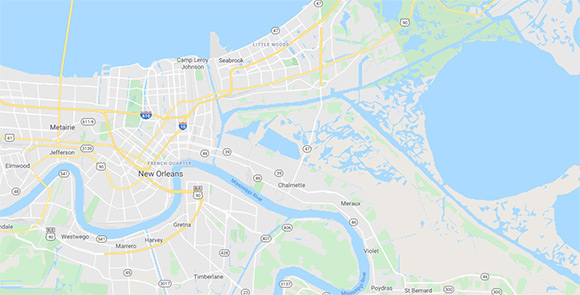- info@NewOrleansanimalattic.com
Call 24/7 for a free quote:
504-777-2903

Attic Animal Pest New Orleans
We are New Orleans Animal Attic, a full service wildlife removal company servicing New Orleans, LA. Our wildlife removal company can assist in a wide range of situations, including when a skunk, groundhog, or other animal decides to make a nest underneath your porch or shed. We will remove the animal and ensure it does not regain access to the area. We always follow humane methods of wildlife control. This means a reliance on live cage traps and a promise to never use poisons, which are both inhumane and ineffective. In fact, we try to interact with the animals as little as possible to maximize their comfort. This means attempting preventative methods and exclusions whenever possible. If that is not feasible, then we move to other methods, such as live cage traps. In addition to dealing with live animals, we can remove dead animals from inside your building or outside of it. We also offer related odor control services since animals are not known for their pleasant smells. Our friendly customer service begins as soon as we start talking to you on the phone. When you call, we will gladly give you free advice for wildlife control. This is frequently enough to let you handle the critter problem yourself. If you do require our services, we will happily provide you with a free estimate with a ballpark figure over the phone. Call us now at 504-777-2903 for a solution to your wild animal problem.
About Pest Animal New Orleans and Our Services:
Licensed and insured in Kentucky
Poison-free Louisville rodent control - rats and mice.
Louisville rat control and rodent removal
Experts in Kentucky bat removal from buildings.
Bat control in Louisville - removal from attics
Louisville raccoon removal and skunk removal.
Raccoon and skunk removal in Louisville
Removal of animals in the attic, like squirrels.
Our Service Range

Our Service Range
Algiers, Aurora Gardens, Barrington Park , Camp leroy Johnson, Carrollton, Chef Menteur, Cutoff, East Gentilly, Faubourg Marigny, Ferncrest, Flamingo Recreational Vehicle and MH Park, Forest Isle, Garden District, Gentilly, Gentilly Terrace, Gentilly Woods, Greens Ditch, Greenville, Huntington Park, Idlewood, Kingswood, Lake Carmel, Lake Catherine, Lake Forest, Lake Oaks, Lake Terrace, Lakeshore East, Lakeshore West, Lakeview, Lakewood Country Club Estates, Little Woods, Lower Garden District, Michoud, Milneburg, Pike Fort, Pine Village, Place De Concorde, Pontchartrain Beach, Rigolets, Seabrook, Seabrook, South Point, Spanish Fort, Stanton, Storyville, Tall Timbers, Tamaron, Timber Grove, Venetian Isles, Vieux Carre, West End, West Lake, and many more!New Orleans Wildlife Removal Tip of the Month: How Bats Drink Water
The bats will definitely feel thirsty after hunting for a long time. When they fly, the bats will be sending out a high-pitch noise and will pay attention to the echoes that returns. If the noise will only be reflected from the surface below, this can possibly mean that they are flying above the pond or lake. In order to quench their thirst, the bat will simply open its jaw to enjoy a supply of fresh water.

How Bats Find Water to Drink
When the Louisiana bats are in their natural environment, the water would be the only element of nature with a smooth surface. The sound wave that the bat will release will obviously bounce off except for the sounds that are aimed directly downward. According to the research, the bats can find water by using this unique process.
You will be surprised to know that the bats do not have to learn this method. Even the bats that have been living in captivity and have never encountered bodies of water will be fully capable of doing this feat. This shows how essential echolocation is for the survival of the bats.
Can New Orleans Bats Look for a Clean Water Source?
The water can differ depending on the quantity and the quality and animals also have varying needs. Some species of animals will be able to survive for years without the need to drink water. This is often true for the animals in the desert that has an issue in looking for a potable water source. According to the research, the bats have the capacity to look for a clean water source. They can also determine the changes in the quality of the water that they’ve been drinking.
Since the wings of the New Orleans bats are large and it is also hairless, it is often prone to dehydration. Even for the bats that have adapted to the life on the desert will require a steady supply of water. The quality of the water may affect them directly. It also has an indirect effect towards them by ingesting the animals that grow on the water. This is how these animals can indicate the quality of the water. Because of their potential to become an environment indicator there has been an increase on the research and the movement to conserve them.
Bats Also Receive Water from What They Eat
The bats will not only receive their daily water supply by drinking water. They may also obtain water from the foods that they eat such as fruits. Some species of bats will enjoy the nectar from the plants. The insects will also have water content. Some bats will be careful in scooping the water in the pond since there can be a predator waiting to ambush them.
Bats are quite technical with regards to how they drink. Sometimes it will simply make use of its tongue and there are times that it will open its jaws to drink water. They will be using echolocation to find a good water source when they feel thristy.

